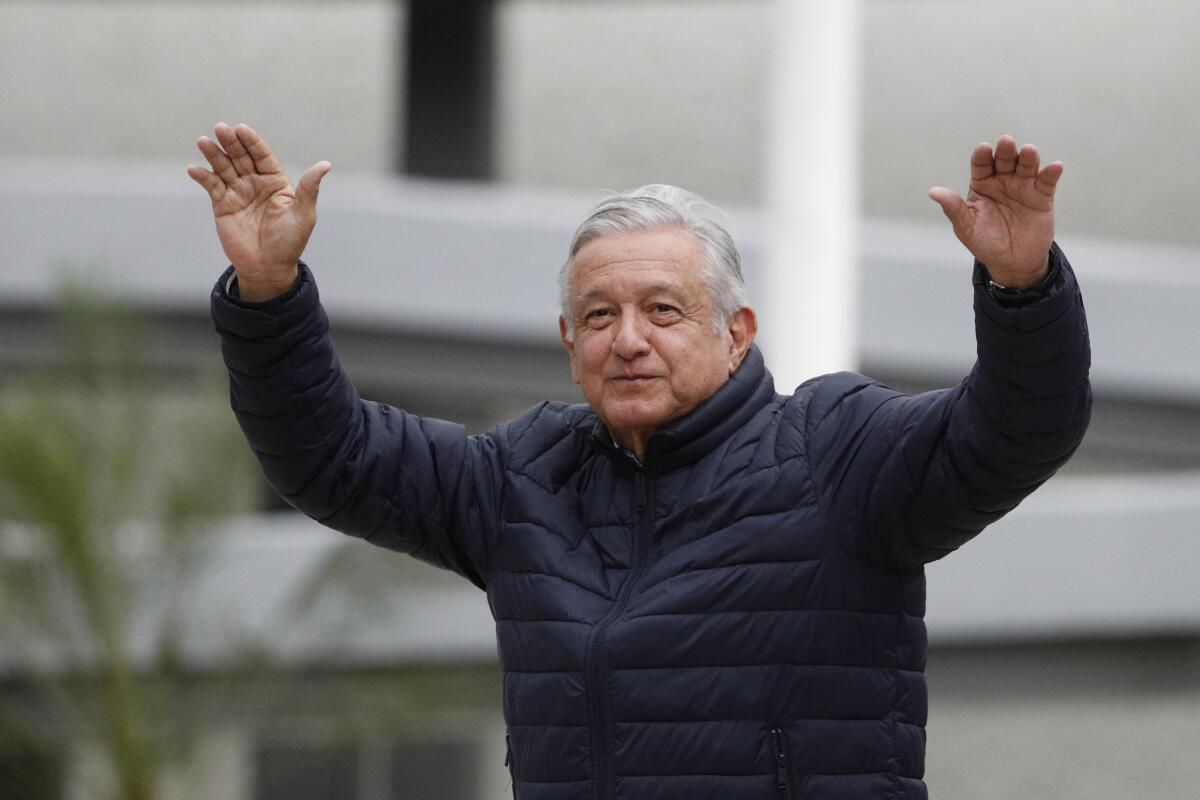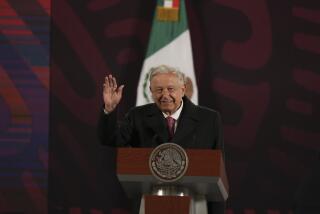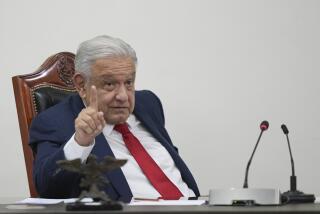Mexico’s president kicks off ‘new normal’ phase amid pandemic

- Share via
CANCÚN, Mexico — Amid a pandemic and a brewing tropical storm, Mexico President Andrés Manuel López Obrador kicked off Mexico’s return to a “new normal” Monday with his first road trip in two months, as the nation began to gradually ease some coronavirus restrictions.
López Obrador said he’s taking all necessary precautions — he drove the 1,000 miles from Mexico City over the weekend rather than flying — on a trip to promote construction of one of his signature infrastructure projects, the Mayan Train.
While the nationwide social distancing restrictions formally ended Monday, the federal government is urging people in so-called “red” zones to maintain most of those measures — and so many people are falling ill and dying each day that those zones cover nearly the whole country.
Mexico has more than 90,000 confirmed COVID-19 infections and nearly 10,000 deaths, both considered to be undercounts.
Mexican officials said last week that more than 5,000 companies had implemented protocols that would allow them to reopen this week. The federal government had cleared businesses in the mining, construction and auto manufacturing sectors to resume operations.
While in Cancún, Quintana Roo, the president was talking up what local officials hope is the quick return of tourists. Mexico’s most popular beach destination officially plans to reopen next week — albeit with restrictions, such as a ban on buffets. Quintana Roo Gov. Carlos Manuel Joaquín González said reservations are already being made.
But around Cancún, nothing appeared normal yet. Beaches were empty, and bars and restaurants remained closed. Locals walked around wearing masks, and traffic was light. The dramatic decrease in international air travel and the April 1 closure of Cancún’s beaches left thousands unemployed.
Cancún resident Andrés José Conrado said it was important to continue with the health precautions.
“I say it’s very early [to reopen],” Conrado said, a cloth mask over his nose and mouth. “For now I say it’s not necessary.”
But Sergio Ortega Jara, another resident who is out of work, said the city needs to get jobs back. He conceded that the virus is a real danger but insisted that people need income.
“It’s kind of bad; there’s no work,” Ortega said.
In Mexico City, traffic has increased significantly in the past week. In some neighborhoods, foot traffic has hardly ever diminished. Mexico City Mayor Claudia Sheinbaum on Monday urged residents via Twitter to stay at home if it wasn’t absolutely necessary to go out.
Still, public spaces that have been vacant of people during the past two months were bustling on Monday. There were protests by police and unemployed musicians in the principal plaza. People strolled in the historic center and along a main boulevard. Cleaning seemed to be happening everywhere, as still-closed offices and restaurants prepared to open.
A long line of people seeking construction permits stretched in front of a city office building. While the city has had some success imposing orderly lines at its subway stations, a commuter bus station was in chaos. Most people were wearing masks.
Renato Rivera stood outside a construction site Monday, wearing a red mask. He had heard that work would be resuming, but when he arrived there wasn’t a job for him.
“It’s not that you’re not scared,” he said of returning to work. “We’re all scared. But we have need. There’s no help from the government.”
On Monday, López Obrador highlighted a couple of hot spots, including the Pacific Coast beach destination Acapulco and his home state of Tabasco.
“We’re going to carefully return to productive activities,” he said.
Later in the day, during a visit to a military base on Isla Mujeres, López Obrador warned that if there were new outbreaks and a surge in infections, restrictions would be tightened again.
For the most part, Mexico’s restrictions have been recommendations. López Obrador repeated Monday that he preferred reasoning with people to “authoritarian impositions.”
López Obrador planned to spend the week promoting the start of construction for the Mayan Train, which will whisk tourists from resort destinations like Cancún into the interior of the Yucatán Peninsula. It has been criticized as an environmental threat and faces opposition from indigenous communities, but he says the project will create 80,000 jobs.
The president has faced criticism for his handling of the pandemic. He continued to travel the country a month after Mexico’s first confirmed COVID-19 case and has continually mixed messages of a need to take precautions with the country’s need to reactivate its economy.
The Mexican government has estimated that 1 million jobs have been lost during the epidemic. Mexico’s central bank projected last week that the economy would shrink as much as 8.8% this year.
On his way to Cancún, López Obrador stopped at his ranch in Chiapas state and recorded a video he shared on social networks. He tried to highlight positive economic signs, noting that the peso has regained a bit of value against the dollar and the price of oil has risen slightly.
“I wanted to give you good news,” López Obrador said. “There is economic recovery. The model we are using is showing us results.”
Meanwhile, the remnants of tropical storm Amanda, which left at least 17 dead over the weekend in Central America, was expected to dump 10 to 15 inches of rain on the Yucatán Peninsula and Gulf Coast states in the coming days.
More to Read
Sign up for Essential California
The most important California stories and recommendations in your inbox every morning.
You may occasionally receive promotional content from the Los Angeles Times.










